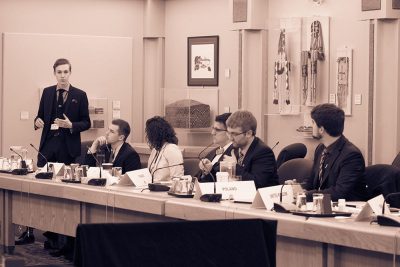
Carleton Model NATO 2023 Committees
1. North Atlantic Council (NAC)
The North Atlantic Council is the principal political decision-making body within NATO. It brings together high-level representatives of each member country to discuss policy or operational questions requiring collective decisions. In sum, it provides a forum for wide-ranging consultation between members on all issues affecting their peace and security. All members have an equal right to express their views and share in the consensus on which decisions are based. Decisions are agreed upon on the basis of unanimity and common accord. There is no voting or decision by majority. This means that policies decided upon by the NAC are supported by and are the expression of the collective will of all the sovereign states that are members of the Alliance and are accepted by all of them. Strictly speaking, the NAC is not the only body within NATO that carries such a high degree of authority. The Nuclear Planning Group (NPG) has comparable authority for matters within its specific area of competence. However, in practice, the NAC convenes far more frequently than the NPG and covers a broader scope of themes – as broad as the member countries decide it should be. Consequently, it is commonly referred to as NATO’s principal decision-making body.
Committee Topics:
- NATO in the Indo-Pacific
- The Eastern Flank
- Arctic Security
2. Military Committee (MC)
The Military Committee (MC) is the senior military authority in NATO and the oldest permanent body in NATO after the North Atlantic Council, both having been formed months after the Alliance came into being. It is the primary source of military advice to NATO’s civilian decision-making bodies – the North Atlantic Council and the Nuclear Planning Group. Its advice is sought prior to any authorization for military action and, consequently represents an essential link between the political decision-making process and the military structure of NATO. This year’s MC will be run as a “wargame,” whereby the Committee
will be responding to a fictitious humanitarian crisis where NATO has been called upon by the UN to assist. Accordingly, no topics will be posted below, but the Background Guide will provide the underlying context and which issue-sets delegates should be familiar with.
- NATO in the Indo-Pacific
- Breakthrough by Archipelago of Design (AOD)
- Space Oddity
3. Euro-Atlantic Partnership Council (EAPC)
The 50-state Euro-Atlantic Partnership Council (EAPC) is a multilateral forum for dialogue and consultation on political and security-related issues among Allies and partner countries. It provides the overall political framework for NATO’s cooperation with partner countries in the Euro-Atlantic area, and for the bilateral relationships developed between NATO and individual partner countries under the Partnership for Peace (PfP) programme. Longer-term consultation and cooperation takes place in a wide range of areas within the framework of the Euro-Atlantic Partnership Work Programme (EAPWP). These areas include crisis-management and peace-support operations; regional issues; arms control and issues related to the proliferation of weapons of mass destruction; international terrorism; defence issues such as planning, budgeting, policy and strategy; civil emergency planning and disaster preparedness; armaments cooperation; nuclear safety; civil-military coordination of air traffic management; and scientific cooperation. The EAPC has also taken initiatives to promote and coordinate practical cooperation and the exchange of expertise in key areas. These include combating terrorism, border security, and other issues related to the proliferation of weapons of mass destruction and small arms and light weapons.
Committee Topics:
- Energy security
- Partnerships on the Eastern Flank
- Caucasus security challenges